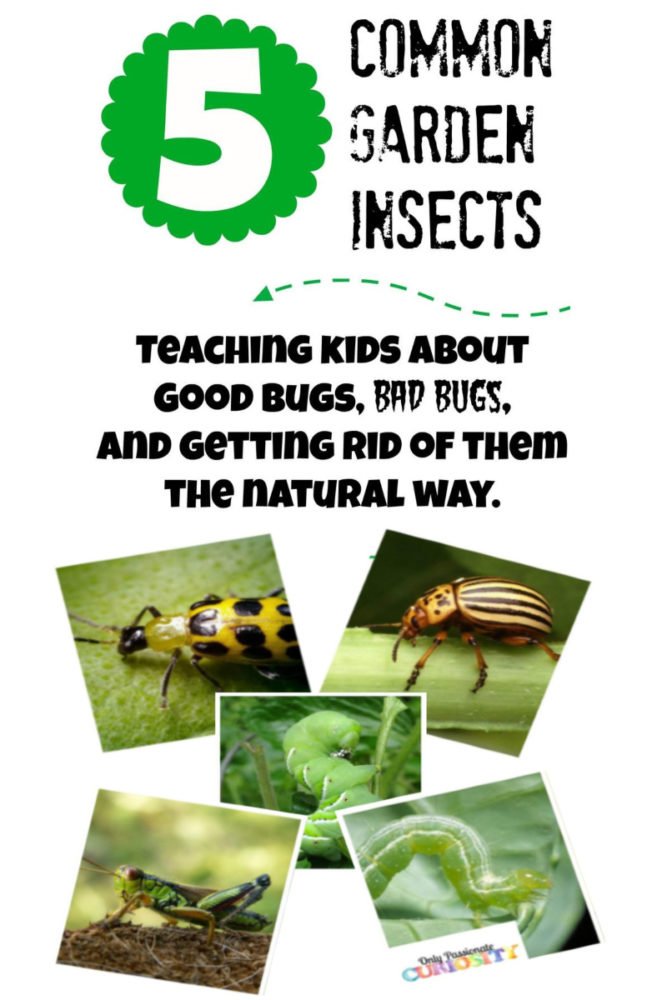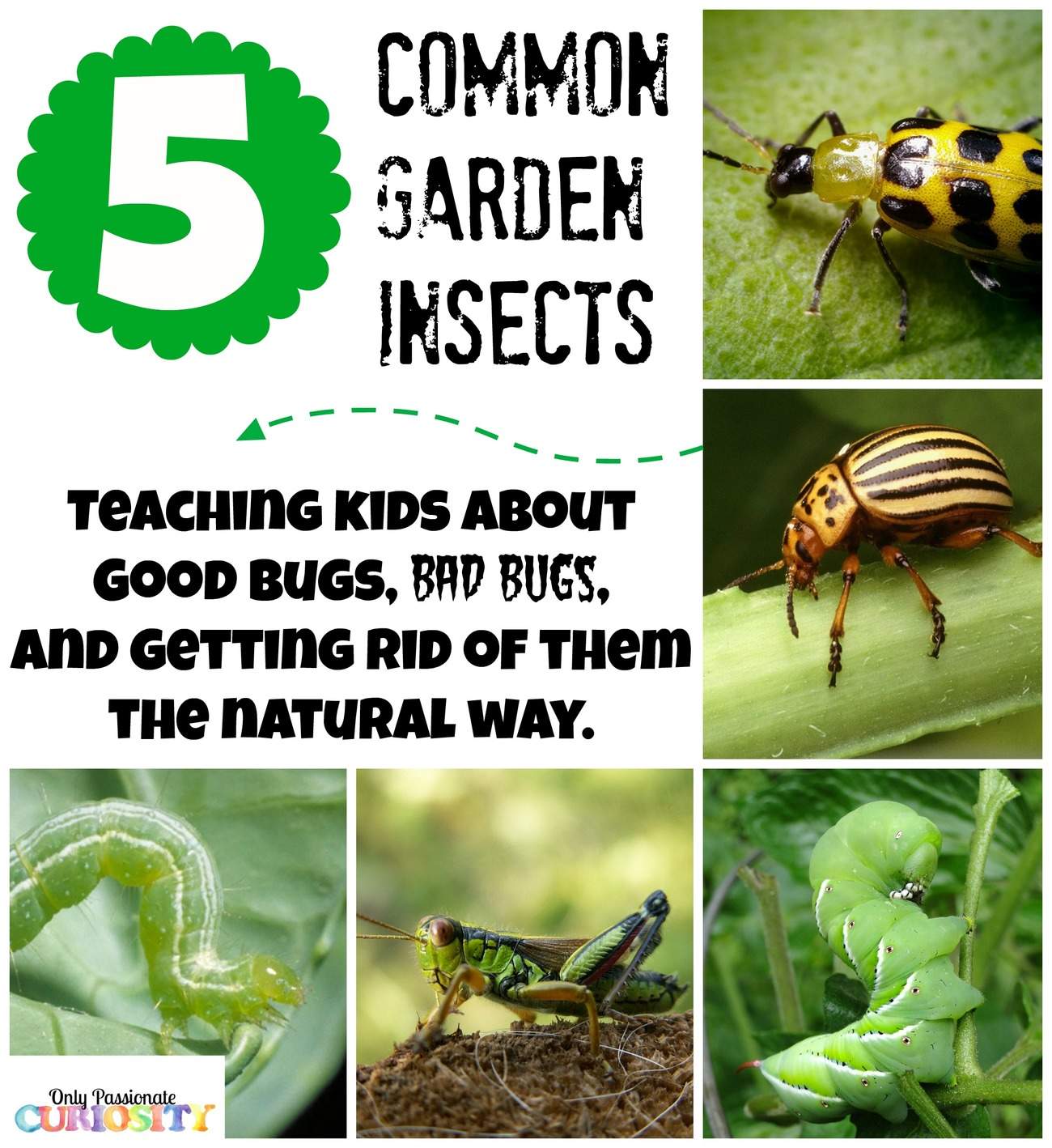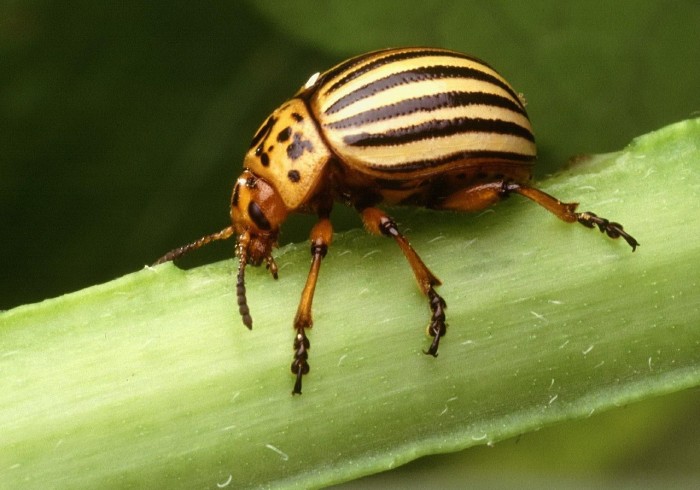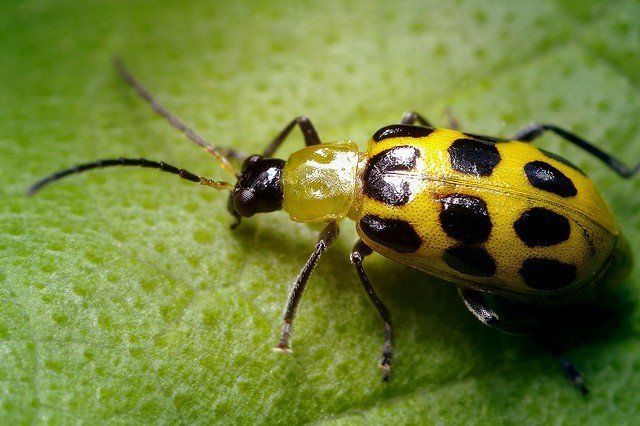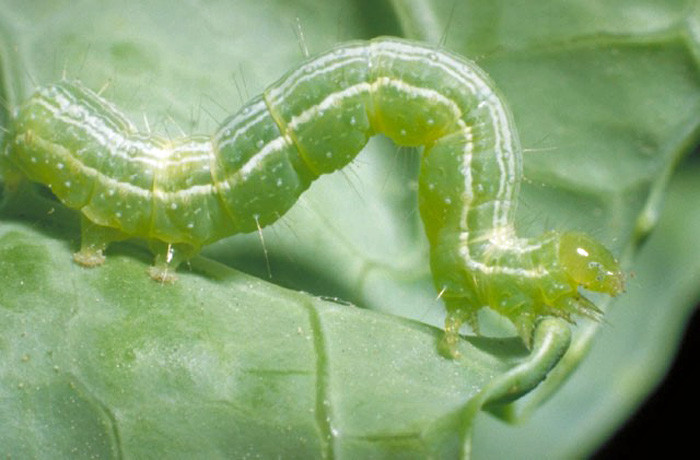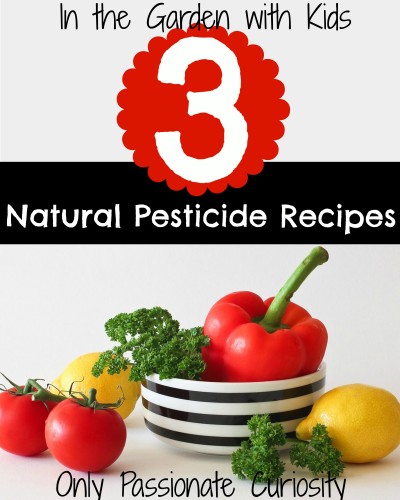Teaching Children about Garden Bugs {and Natural Pesticide Recipes}
“No! You can’t have any! It’s mine!”
I get stingy when I find insects munching on garden plants. But that’s not the attitude I want to train into my children. As parents, we want our children to grow up understanding the importance of being generous and giving. We want them to know the value of sharing. But even with garden bugs?
Not exactly. It doesn’t mean we sit back and watch plant-munching insects get fat on the tomatoes intended for our pizza and cabbage for our coleslaw. When it comes to sharing our garden produce, we draw the line with planting-eating garden bugs! But we do so gently and teach our children about stewardship.
In the garden, we teach our young gardeners that we are stewards over the land. It’s our responsibility to care for the plants; that includes protecting them from invading munchers.
As parents, it’s our responsibility to keep our children safe while they learn about growing nourishing plants. In this post, you will learn about four garden bugs that are harmless to touch and how to make a safe natural pesticide spray to keep the pests away in case they get stubborn and want to stay.
Tomato Hornworms, Grasshoppers, Spotted Cucumber Beetles, and Cabbage Leaf Loopers are harmless to people but destructive to our plants. They are also all too common among backyard gardens. So let’s learn how to spot these garden bugs, remove them, and keep them from coming back.
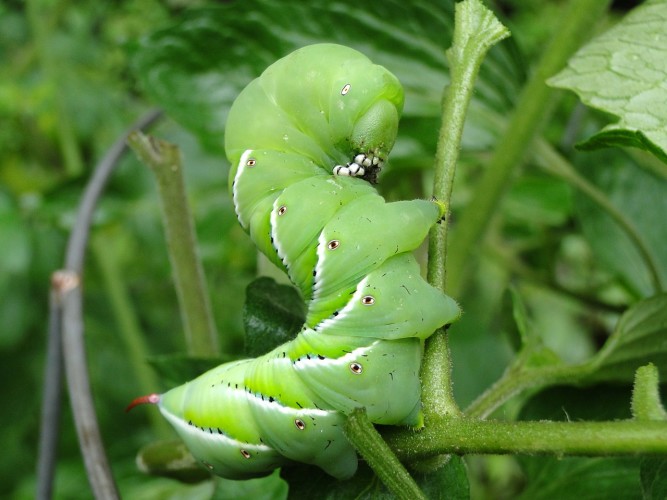
1) Tomato Hornworm Moth
Tomato Hornworms are among the list of worst plant destroyers. One worm–actually a caterpillar–can destroy a plant overnight. And they camouflage with the plant so well they can be difficult to spot. So prevention is always the best medicine. You guessed by their name that Tomato Hornworms mostly like tomato plants. But, they will also go for eggplant, pepper, and potato.
How to Spot A Tomato Hornworm
In their most destructive stage, Tomato Hornworms appear as green caterpillars. They can be up to 5 inches long! When you see stems and no leaves on your plants, you have a hornworm problem, most likely.
How to Prevent Tomato Hornworms
Till your soil before planting! In early spring, before you plant, till up the soil in your planting bed to expose Tomato Hornworm cocoons or larvae. If you find any in the soil, you can pick them up to toss into a pail of soapy water. (I like castile soap.) Or you can feed them to your chickens (if you have any) or let native birds come find them.
Plant companion plants. Grow dill, lobelia, lemon balm, and/or marigolds alongside your tomatoes to attract (non-stinging) parasitic wasps that will eat tomato hornworm larvae.
Attract birds. Add a bird bath to your garden to attract birds so they will eat the cocoons and/or hornworms before they get to your plants.
Some years, even after we do all we can to keep the garden bugs away, they come anyway. In this case, switch from prevention to intervention.
Intervention for these Garden Bugs
Chickens and Castile Soap Even with all your planning and forethought, tomato hornworms might manage to find their way to your plants. Now what? Well, you can simply pluck them off your plants with your fingers. They are harmless. They don’t bite or sting people. (Wear gloves, if you like. I do!) Toss them into a container to feed to your chickens or put them into a bucket of soapy water…where they will drown. (Sad. I know.) Scoop the no-longer-living caterpillars out of the bucket to put into a sealed bag and add them to the week’s trash. As a last resort, you can squish them.
Natural Homemade Spray Recipes If your Tomato Hornworms won’t take “no” for an answer, make a naturally safe plant spray using one of the recipes further below.
2) Grasshoppers
Here’s your chance to combine science with P.E. because if you want to catch grasshoppers, you better be quick! But, the fun is in trying. So go for it! Grasshoppers are harmless to people.
When your kids get tired of leaping after grasshoppers, you can apply the same natural pesticide spray recipe you used to defeat tomato hornworms to also scare off grasshoppers.
Prevention
Before you start planting anything in the ground, thoroughly till up the soil around your planting area to expose any eggs so the birds can find them. Or, you can pick them up and put them into a sealed bag or squish them.
Grow a variety of plants that are known to repel grasshoppers, like cilantro, calendula (Pot Marigold), sweet clover, peas, and horehound.
Intervention for these Garden Bugs
For the ones that get away, use one of the natural homemade sprays (see recipe), lay traps, or cover your plants with lightweight floating row covers.
- Spray the grasshopper and the plant with a natural spray solution below.
- Cover your plant(s) with a a floating row cover that you can purchase from a garden supply source.
- Lay traps by burying glass jars in the soil around your plants. Make a mixture of one part unsulfured molasses and 10 parts water. Fill each jar halfway with the molasses mixture. The sweet fragrance attracts grasshoppers, and they fall into the jars and drown. Say “Bon voyage, mon ami.” (Bonus: You just combined science, PE, and French!)
3) Colorado Potato Beetle
The three-eighths-inch-long, yellow and black striped beetle loves devouring potatoes, tomatoes, peppers, and eggplant. Mostly, it goes for the foliage. But this beetle can do a lot of damage in very little time. Fortunately, it’s safe to handle, so pick them out of your garden. Pronto!
Prevention
- Rid your garden of “attractive weeds” that Colorado potato beetles like to eat, including ground-cherry, jimsonweed, thistle, mullein, and horse nettle.
- Use a barrier, such as cheesecloth or a lightweight floating row cover, on young plants and seedlings to prevent beetle damage.
- Plant coriander, dill, sweet alyssum, fennel, and cosmos around your potato patch to attract ladybugs and stink bugs into your garden to prey on beetle eggs and larvae. Or make this ladybug house with your children and place it in your garden.
Intervention for these Garden Bugs
If your potato’s foliage is missing, you have Colorado potato beetles, most likely. Start checking the undersides of the leaves and dig through your soil. When you find the yellow striped critter, remove it by hand or shake it off your plants so it falls into a bucket of soapy water. Look for black and yellow larvae and brick red egg clusters. Remove those from your plants, too. They can join the adults in the soap bath…
4) Spotted Cucumber Beetle
How can something so small be so destructive? The yellow-and-black spotted Cucumber Beetle–and their larvae– cause big trouble for about 270 kinds of plants and trees. Yikes! The plants which are most vulnerable in your vegetable garden include asparagus, broad beans, eggplant, potatoes, certain fruit trees, tomatoes, peas, squash, corn (a favorite!), cucumbers, potatoes, fruits, and melons.
You’ll know if you have a cucumber beetle problem if your plants look wilted or drought-stressed, but you know they’re getting the right amount of water. Act swiftly to start eliminating this invader from your garden.
Prevention
- Companion plant your garden with insect-repelling plants like broccoli, calendula, catnip, goldenrod, nasturtiums, radish, rue, and tansy. If you want to try marigolds to repel them use the more pungent varieties like African, French, or Mexican marigolds.
- Place cuttings of the tansy plant as a mulch in between rows in the garden.
- Spread onion skins (any type) on the soil around the planted areas.
Intervention for these Garden Bugs
- Cucumber Beetles are safe to handle, so pick them up and put them into soapy water.
- Bats are wonderful insect-eaters. Make a project of building a bat habitat (house) or two to keep bat nearby and patrolling for insects at night while you sleep.
- Hopefully you won’t experience a severe infestation. But if you do, you may need to resort to using Neem Oil.
5) Cabbage Leaf Looper
If you spot what looks like something took a big bite out of your cabbage leaf, start hunting for a cabbage leaf looper. Look UNDER leaves. This is another caterpillar-type critter that blends into the background and munches away without a care in the world. But he’s not satisfied with cabbage alone. Oh, no! This friendly freewheeling freeloader wants to chomp into your broccoli, cauliflower, kohlrabi, and collard greens. Also known as an “inchworm,” these garden bugs will also attack potato, tomato, spinach, and cucumbers. So if you see this green caterpillar crawling about, pick him up and drop him into a bucket of soapy water. “Bon voyage, mon ami.”
Prevention
- Cover your plants with floating row covers during the springtime to keep the white cabbage butterflies from laying their eggs on the plants. But, when it starts warming up and your plants are growing, remove the row covers.
- Just like tomato hornworms and beetles, you can easily keep small populations of cabbage loopers under control by picking the insects off the plants and dropping them into a bucket of soapy water.
- Keep your garden clean, especially in the fall because Cabbage Leaf Loopers overwinter in garden debris.
- Plant flowers, such as calendula, sunflower, daisy, alyssum, or dill nearby to attract beneficial insects that attack and kill cabbage loopers and cabbage butterflies.
- Another reason to build a bat house: Cabbage Leaf Loopers, in their moth stage, fly at night…and so do bats.
Intervention for these Garden Bugs
- Yep. You guessed it. The Cabbage Leaf Looper is destined for a bubble bath. Pick up any you find and drop them into a bucket of soapy water.
- Spray your plants using one of the natural pesticide recipes below.
Homemade Natural Pesticide Recipes
These recipes will work for all the garden bugs listed above, with the exception of the cucumber beetle.
What to do: Once per week, spray your plants and surrounding soil. Experiment with these natural pesticide recipes to see which one works best in your garden. (Even though each recipe is all-natural and non-toxic, please exercise care to avoid getting spray in eyes or on skin. Wear gloves, eye protection, and spray downwind to be safe.)
- Spray your plants thoroughly, including leaf undersides. You might need to drench your soil, too.
- Store the mixture(s) for up to 1 week in a well-labeled, covered container in the refrigerator, out of reach of children.
- You need one 8-ounce or larger spray bottle.
Peppermint Oil Recipe
8 ounces water
1 tablespoon of liquid soap. (I like Castile. it’s olive oil based.)
10-15 drops pure essential oil of peppermint
Dill Oil Recipe
8 ounces water
1 tablespoon of liquid soap.
10-15 drops pure essential oil of dill
Garlic & Cayenne Blend
Chop, grind, or liquefy one garlic bulb and one small onion.
Add 1 teaspoon of powdered cayenne pepper to 1 quart water.
Steep 1 hour, strain through cheesecloth, then add 1 tablespoon of liquid dish soap to the strained liquid; mix well.
Gardening Is A Great Activity for Understanding Stewardship
There’s a wealth of learning to be had inside a garden, like learning how to be stewards over plants and animals: we take care of them and they take care of us in return. Take a stroll outside now to see what’s happening in your garden, or look for a place to start one. Don’t forget to take a bucket of soapy water along with you…just in case.
RESOURCES
Good Bug, Bad Bug, and How to Tell the Difference



